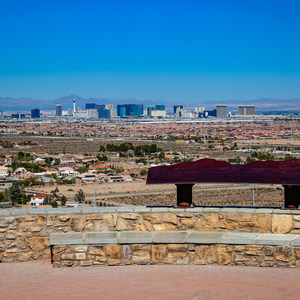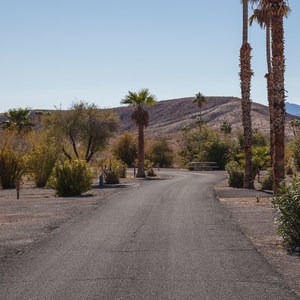Sloan Canyon National Conservation Area boasts roughly 300 distinct rock art panels with a large portion concentrated within Petroglyph Canyon. BLM archaeologists have cataloged up to 1,700 different petroglyph design styles in this area alone. The hike to Petroglyph Canyon begins on Trail 100 in a wide wash that is typical of the Mojave Desert, but it soon gains a canyon feeling as the walls and gradient steepen. The predominant rock type seen in this area is dacite, which is a fine grained igneous (volcanic) rock that ranges in color from grey to black and may take on additional hues depending on the presence of iron oxide. Additionally, the rock may take on a golden sheen due to the oxidizing of a mineral called biotite, which is called “brassy biotite.” The wash continues south to a fork in the canyon, and the split off trail to the west is signed as Trail 200. Following either trail will eventually lead to the main petroglyph gallery, but staying east on Trail 100 is the most scenic way to travel to through the canyons.
Continue through a narrow section that has a few minor scrambles up low angled slabs to gain access to the main petroglyph gallery. Petroglyph panels are scattered amongst the boulders on the hillside, so spend time thoroughly exploring the area to grasp the extent of the artwork; however, be careful to avoid touching the petroglyphs as the oils from skin can damage the rock art panels. After viewing the main area, continuing south on Trail 100 will lead to a junction with Trail 200 and Trail 300. To return to the main parking area for Sloan NCA return north on Trail 200, but for the intrepid trekker, hiking along Trail 300 can add rewards of Bighorn sheep during the spring months on the rocky outcrops of the canyon walls and peaks.
The Petroglyph Canyon Area is a part of the larger Sloan Volcanic Section which is compromised by four 13-million-year-old extinct volcanoes, and Petroglyph Canyon predominantly slices through the Mount Sutor Volcano. Volcanic domes are readily seen in the area, and they are formed from viscous lava pushing up through vents and hardening. Look for vertical banding on the hike into the canyon, which is evidence of where the flow patterns were embedded.
Additionally, the Sloan Canyon area is a fabulous place to view wildflowers in the spring months of March to May, especially after wet years. Beavertail cactus, Brittlebush, Chia, Creosote Bush, Desert Chicory, Desert Trumpet, Fremont Pincushion, Globemallow, Mojave Yucca, Notch Leaf Phacelia, Rosy Two-Tone Beardtounge, Sundrop, Teddy Bear Cholla, White Bursage, and White Desert Primrose are some the main plants that characterize the area.





























Comments
Sign In and share them.